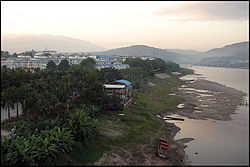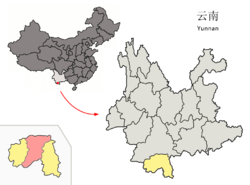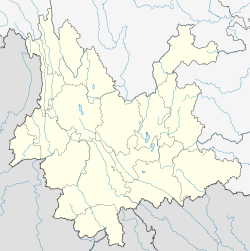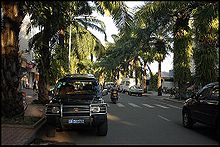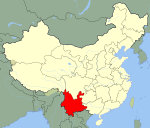- Jinghong
-
Jinghong
景洪

เชียงรุ่ง— County-level city — 景洪市 Looking west along the Mekong river in the evening from the new bridge, prior to the redevelopment of the waterfront. Location of Jinghong City (pink) and Xishuangbanna Prefecture (yellow) within Yunnan province of China Location within Yunnan, China Coordinates: 21°59′N 100°49′E / 21.983°N 100.817°E Country China Province Yunnan Prefecture Xishuangbanna GB/T 2260 CODE[1] 532801 Area – Total 7,133 km2 (2,754.1 sq mi) Population (2010)[2] – Total 519,935 – Density 72.9/km2 (188.8/sq mi) Time zone China Standard Time (UTC+8) Postal code 666100[3] Area code(s) 0691[3] Website jhs.gov.cn 1Yunnan Statistics Bureau [1]
2Xishuangbanna Gov. [2]
3Yunnan Portal [3]Jinghong (Chinese: 景洪; pinyin: Jǐnghóng; Dai / Tai Lü:
 , pronounced [tsêŋhuŋ]; Thai: เชียงรุ่ง, also (formerly) romanised as chiang rung, chiang hung, chengrung, cheng hung, jinghung, keng hung and muangjinghung) is the capital of Xishuangbanna Dai Autonomous Prefecture, Yunnan province, China, and the historic capital of the former Tai kingdom of Sipsongpanna.
, pronounced [tsêŋhuŋ]; Thai: เชียงรุ่ง, also (formerly) romanised as chiang rung, chiang hung, chengrung, cheng hung, jinghung, keng hung and muangjinghung) is the capital of Xishuangbanna Dai Autonomous Prefecture, Yunnan province, China, and the historic capital of the former Tai kingdom of Sipsongpanna.Contents
Location
Located between 100°25' - 101°31' East and 2127' - 2236' North. Yunnan Province borders Sichuan and Guizhou Provinces to the northeast, Tibet Autonomous Region to the northwest, and Guangxi Province to the east. Xishuangbanna borders Myanmar to the southwest and Laos to the southeast.
Geography
The city is limited to the south by Hengduan Shan Mountain Range, Lancang River (Mekong River) passes by Jinghong. Two bridges near the city span this river, which flows south-east towards Laos.
Climate
Climatically, Jinghong contains elements of both a tropical wet and dry climate and a humid subtropical climate (Koppen Aw and Cwa, respectively). The city has a generally humid climate with strong monsoonal influences; summer is long and there is virtually no "winter" as such. Annual sunshine hours amount to between 1800 and 2300 and annual rainfall to between 1100 and 1700mm.
Climate data for Jinghong (1954—2007) Month Jan Feb Mar Apr May Jun Jul Aug Sep Oct Nov Dec Year Average high °C (°F) 25.3
(77.5)28.5
(83.3)31.7
(89.1)33.4
(92.1)32.6
(90.7)31.4
(88.5)30.4
(86.7)30.6
(87.1)30.7
(87.3)29.1
(84.4)26.5
(79.7)24.1
(75.4)29.5 Average low °C (°F) 11.4
(52.5)11.6
(52.9)13.9
(57.0)17.6
(63.7)20.8
(69.4)22.5
(72.5)22.5
(72.5)22.3
(72.1)21.4
(70.5)19.6
(67.3)16.1
(61.0)12.8
(55.0)17.7 Rainfall mm (inches) 16.6
(0.654)12.3
(0.484)22.2
(0.874)52.8
(2.079)140.4
(5.528)169.9
(6.689)220.9
(8.697)221.0
(8.701)139.3
(5.484)95.6
(3.764)53.6
(2.11)21.6
(0.85)1,166.2
(45.913)Source: National Meteorological Centre of China History
Main article: Heokam kingdomYuan Dynasty
During the Chinese Yuan Dynasty, the Tai kingdom of Sipsongpanna began a close and long-lasting relationship to Lanna, another historic Tai kingdom that lay south. In 1296, Lanna's capital Chiang Mai was founded by Mangrai, whose maternal grandfather was King Rung Kaen Chai (Thai: รุ้งแก่นชาย) of Jinghong (ie: Sipsongpanna).
The kingdoms of Sipsongpanna and Lanna maintained ties of migration, intermarriage and long distance trade over the subsequent centuries, though later, as Lanna's power grew, parts of the Sipsongpanna region fell under Lanna's control.
Ming Dynasty
In 1401 during the Chinese Ming Dynasty, the Sipsongpanna Tai ruler Tau Se Da Xam (pinyin dao xianda) attacked a smaller Tai area to the north known as Weiyuan (Tai; or pinyin Weiyuan; apparently[4] equivalent to modern Jinggu). The Ming administration sought to retaliate but adopted a cautious response of diplomacy and Tau Se Da Xam withdrew his troops. About this period Sipsongpanna began to pay tribute to the Ming.
In 1405 the Sipsongpanna Tai attacked Chiang Mai, in conjunction with Ming Chinese troops.
In 1421 the Chinese attempted to cause a split in Sipsongpanna by backing multiple administrations during a period of civil strife, but their plan failed to succeed.
1448 saw the defeat of Mong Mao, a Tai state in eastern Burma, by a combination of Chinese, Sipsongpanna and allied forces united under the Ming.
In the 1450s another struggle for succession arose in Sipsongpanna, with one faction backed by Kengtung and one by Chiang Mai. Despite the Kengtung faction's victory, conflict started with that state shortly afterwards.
The Burmese Toungoo state arose in the 1530s to crush Chiang Mai, and its influence also extended to Kengtung and Sipsongpanna, which like other Tai kingdoms soon began to pay tribute.
Transport
- Xishuangbanna Gasa Airport is the second largest airport in Yunnan, located just five kilometers from the downtown. Flights to Kunming, Shanghai, Chengdu and other major cities in China run regularly. There is one weekly international flight to Luang Prabang (resumes 1 November).
- The city has the largest public transportation center in Xishuangbanna and connects travelers to nearby cities, towns and villages.
- China National Highway 214
- China National Highway 213
Places of interest
The Dai Water Splashing Festival and nearby villages of that and other ethnic groups are the main attractions. Additionally, at least three botanical parks and gardens and are located in or near the city.
Notes
- ^ http://www.stats.gov.cn/tjbz/xzqhdm/index.htm
- ^ According to 2010 China National Census
- ^ a b Area Code and Postal Code in Yunnan Province
- ^ Wade, Geoff. "Wei-yuan (威遠): Southeast Asia in the Ming Shi-lu: an open access resource". Asia Research Institute and the Singapore E-Press, National University of Singapore. http://www.epress.nus.edu.sg/msl/place/1757.
References
- Civility and Savagery: Social Identity in Tai States. Turton, Andrew. Routledge, 2000. (ISBN 0700711732)
- Asian Borderlands: The Transformation of Qing China's Yunnan Frontier. Patterson Giersch, Charles. Harvard University Press, 2006. (ISBN 0674021711)
External links
Categories:- County-level divisions of Xishuangbanna Prefecture
- Tourism in Yunnan
Wikimedia Foundation. 2010.

